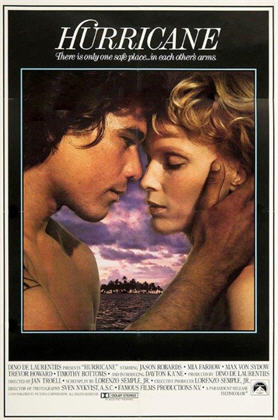
“If the gods meant me for another, why did they send you!?”
Director: Jan Troell
Starring: Mia Farrow, Dayton Ka’ne, Jason Robards, Trevor Howard, Max Von Sydow, Timothy Bottoms, James Keach, Ariirau Tekurarere
Screenplay: Lorenzo Semple Jr and Roman Polanski (uncredited), based upon the novel by Charles Nordhoff and James Norman Hall
Synopsis: American Samoa, the 1920s. Charlotte Bruckner (Mia Farrow) arrives in Pago Pago from Boston to visit her father, Captain Bruckner (Jason Robards), who is military governor of the American territory. Though a rainstorm interrupts their greetings, Charlotte is thrilled with her surroundings, and looks forward to using her visit to work on her art. At the governor’s residence, Charlotte is overwhelmed to find that the American community has organised a surprise party to welcome her; she is also pleased to be reunited with Ensign Jack Sanford (Timothy Bottoms), an old flame. However, as the two dance, Charlotte’s attention is caught by a young Samoan man, Matangi (Dayton Ka’ne), who has a position on the Governor’s staff. The following morning, Sanford shows Charlotte around the village, explaining some of Pago Pago’s history and expressing his doubts about the wisdom of continued American governance. At the urging of Matangi, though he is unseen by Charlotte and Sanford, a young Samoan woman thrusts a note into Charlotte’s hand. As it is written in Samoan, Bruckner asks Matangi to translate. Matangi explains that it is from a native girl whose lover was jailed for stealing a canoe, which he did in order to go to her; the note begs Charlotte to intervene with her father on the young man’s behalf. She does so willingly, but Bruckner scoffs at the idea that he would accept love as an excuse for breaking the law. However, when he sees the note and recognises Matangi’s handwriting, Bruckner’s dismissive attitude turns to anger, not only because of Matangi’s attempt to involve Charlotte in his effort to help the young couple, but because of his interference in the administration of the law. When Matangi has been dismissed, Bruckner shakes his head, wondering why he puts up with him. A junior officer reports that Bruckner will no longer have to: Matangi’s father has died, and the young man is now High Chief of the island of Alava. Though Sanford tries to rekindle their romance, Charlotte is more and more drawn to Matangi. She makes one of the American delegation to Alava, invited to witness Matangi’s ascension, and is introduced to Father Malone (Trevor Howard) and Dr Danielsson (Max Von Sydow). Matangi’s first act as High Chief is to challenge Buckner’s authority, adding a rider to his Oath of Allegiance – “Such as I think they are good for my people” – and questioning several of Buckner’s judicial decisions. During the ceremony, Charlotte learns that Matangi is shortly to be married to Moana, who she recognises as the young woman who gave her the note. Later, Matangi performs a heated dance with Moana—but his eyes are on Charlotte… Afterwards, Charlotte argues her father into letting her stay on Avala as the guest of Dr Danielsson; he tells her he will pick her up in one month’s time, when he returns to attend Matangi’s wedding—a statement that makes Charlotte flinch. As they prepare to leave, Jack Sanford warns Charlotte to be careful. She pretends not to understand him—but before long, she and Matangi are spending every moment together…
Comments: Given my conclusion that John Ford’s 1937 production, The Hurricane, is not in fact a disaster movie, in spite of the spectacular storm sequence which comprises its climax, some readers might be wondering why I have placed the Dino De Laurentiis-produced, Jan Troell-directed version of the story on the other side of the fence. There are several answers to this question, the overarching one being that there is more than meaning attached to the term, “disaster movie”…
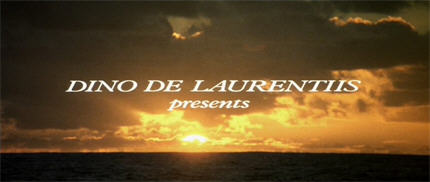

Hurricane was conceived in 1974, when John Alarimo came across a copy of the Charles Nordhoff and James Norman Hall novel, The Hurricane, also the source of the John Ford film. Inspired, Alarimo carried both the book and a print of the Ford adaptation to Dino De Laurentiis, and successfully persuaded him to produce a new version of the story. It was another five years, however, before the project came to fruition. Though pre-production (or pre-pre-production) of Hurricane was set in motion, for the next two years most of Dino’s attention was focused elsewhere…
This is a slightly shameful admission, I suppose, but until I chose it for this Roundtable I had never seen Hurricane in full—and now, having done so, what struck me most forcibly is how exactly its mistakes replicate those that doomed the remake of King Kong, released three years earlier. Though, mind you, while I say “doomed”— While at this distance we tend to think of King Kong as an unmitigated disaster, and an unforgiveable exercise in hubris to boot, at the time of its release in December 1976 the film was a financial, if not a critical, success, and went on to become the fifth highest-grossing film of 1977.
So perhaps it is not surprising that Dino De Laurentiis did not perceive his various choices as “mistakes” at all, when he took exactly the same approach to the production of Hurricane—allocating a budget of over $20 million dollars, tapping Lorenzo Semple Jr to deliver a new adaptation of the Nordhoff-Hall novel, and putting unjustified faith in the power of special effects to overcome any production deficiencies.
Furthermore, holding hard to his conviction that movie audiences would no longer “buy” a film not shot on location, De Laurentiis sent John Alarimo out to scout locations and identify potential extras. The “Skull Island” sequences of King Kong had been shot on Kauai, but that no longer seemed sufficiently remote or exotic.
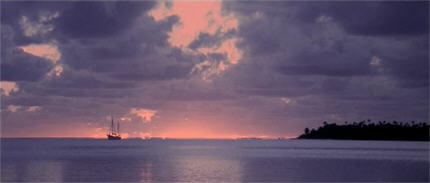
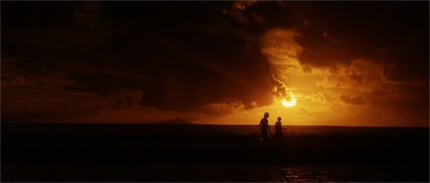

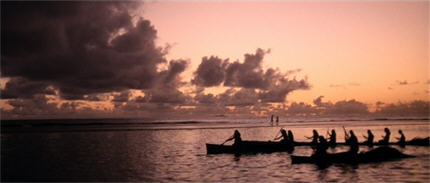
One positive thing…
One after the other, De Laurentiis rejected Hawaii, the Bahamas and Samoa as a possible backdrop for his film (which is of course actually set in Samoa), before taking the mindboggling decision to shoot Hurricane in Bora Bora—which at the time could only be accessed via a torturous journey via Honolulu, Samoa and Tahiti, and where in addition to limited accommodation, and associated limited facilities (like minimal plumbing), electricity was restricted and telephones non-existent. There was a Club Med, which had its own generator; but the organisation demanded what De Laurentiis – even with his expansive ideas about budgets – considered an outrageous price in exchange for renting out its accommodation.
Not to worry. Rather to give in to what he viewed as attempted extortion, De Laurentiis authorised the construction of a hotel, which was intended to house his cast and crew during production. (He viewed it as an investment, intending to follow Hurricane with The Bounty, a production that didn’t happen, at least not when and how originally planned.) Today, “Dino’s Folly” is still operational as the Sofitel Bora Bora.
Before long, however, where to house his production was the least of the producer’s worries. Although he had rejected an offer to direct King Kong, Roman Polanski was the original director assigned to Hurricane, and he was extensively involved in the film’s pre-production—right up until March, 1977, when he was arrested on what the media of the time described tactfully as “a morals charge”. The news reached Bora Bora right in the middle of Dino De Laurentiis’s stand-off with Club Med. When Polanski was ordered to undergo psychiatric evaluation, and confined for forty-two days, De Laurentiis responded by releasing him from his contract, but made no public statement more definitive than an expressed concern about Polanski’s “future availability”. He also refrained from hiring a replacement director, choosing instead to wait and watch events unfold; a decision he was to regret when, in February 1978, Polanski fled America for France. Almost simultaneously, a real hurricane hit Bora Bora, damaging the new hotel, wrecking some of the sets and delaying the production for several months.
Mmm-hmm…
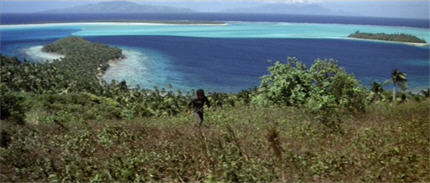



…that can be said about Hurricane is that…
Now being, in classic De Laurentiis style, behind schedule and over budget before shooting could even begin, Hurricane’s most urgent need was a new director—and in what seems a rather peculiar choice, Jan Troell was offered the job.
Though even to this day Troell is not well-known in America (and at the age of eighty-four, he is still going strong), he is very much admired in Europe and has been multiply awarded over the decades. In the early seventies, he achieved international acclaim and success with his paired epics, Utvandrama (The Emigrants) and Nybyggarna (The New Land), about Swedish farmers settling in Minnesota during the 19th century. Despite being edited for length in the US, both films attracted numerous awards and were nominated for Best Foreign Film. Perhaps it was this that suggested Jan Troell to Dino De Laurentiis; or perhaps it was the films’ spectacular use of locations.
Alternatively, either Sven Nykvist or Max Von Sydow may have suggested their compatriot—though in the latter case, I’m inclined to suspect it was the other way around. The role of Dr Danielsson is so trivial, it is easier to imagine Von Sydow getting involved in Hurricane simply as a favour to Jan Troell, with whom he enjoyed a professional relationship every bit as significant as his partnership with Ingmar Bergman.
But whatever the circumstances of his hiring, almost as soon as he arrived in Bora Bora two things must have been evident to Jan Troell: (i) he had made a mistake; and (ii) he was trapped.




…it is very beautiful to look at.
Whatever we make in artistic terms of Dino De Laurentiis’s decision to shoot Hurricane in such a remote location, one of its more immediate consequences was to create a set where tensions were running high even before production got underway in earnest, with the cast and crew unable to get away from either the production itself, or from one another. It is not particularly surprising that, under the circumstances, and despite the isolation of the shoot, stories of “a troubled production” began to drift out of the South Pacific and find their way into the American tabloids.
What is surprising, however – at least from one perspective – is how much this process was facilitated by De Laurentiis himself who, far from trying to disguise the situation, repeatedly invited journalists to the set. Though this presumably done out of a combination of publicity-mindedness and hubris – “Just look at the challenges I overcame to bring you Hurricane!” – in the majority of cases, the journalists in question were far less interested in the complicated logistics of the production than they were in the behaviour of Mia Farrow.
According to various reports, Farrow had started out by going bull-headed for Jan Troell and, when that enterprise came to an abrupt halt—presumably because one of the journalists invited to the set was Agneta Ulfsäter, to whom Troell has now been happily married for more than thirty years—turned her attentions to Sven Nykvist. (The latter, if true, has an ironic component, as we shall see.) Most startling of all, however, was the assertion that there had been a physical confrontation between Farrow and her co-star, Timothy Bottoms; that – depending upon which version of the story you believe – she had attacked him; that he had lost his temper during an argument and hit her; or that he had hit her back after she hit him first.
By the time Roger Ebert arrived on-set in the middle of 1978, “troubled” was putting it mildly. As Ebert later reported, what he found on Bora Bora was a collection of very unhappy actors—not one of whom would talk to him about the film they were making; about anything else, sure, but not that. The stonewall broke down a little over the course of Ebert’s visit, however, and in the long run it became apparent that whatever else was creating problems on the set of Hurricane, the thing causing Jan Troell and his actors the most concern was the script.
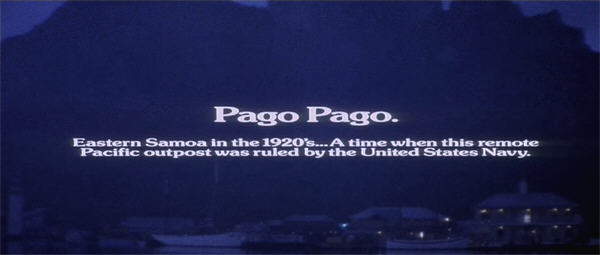
…and when free love between the daughter of the area’s white governor and the local native chieftain was barely worthy of comment…
They were right to worry.
The idea that, if a film is “big” enough, the script isn’t all that important is embarrassingly evident all throughout Hurricane, which serves up a story that would have been creaky even at the time of the film’s setting, the 1920s, and then peppers it with tacky “modern” touches that leave the viewer caught between laughing and squirming. Lorenzo Semple Jr was another hangover from King Kong (where the script is also, shall we say, problematic), and his screenplay boasts an almost bewildering array of wrongheaded choices—the overriding one being the decision to turn the original novel’s (and original film’s) culture-clash tragedy into a ridiculous “forbidden love” romance: one enacted against admittedly spectacular backdrops, but doomed from the outset due to a deadly combination of inappropriate casting and hilariously unsubtle characterisations.
The result is an overblown melodrama that ended up being hurriedly withdrawn and shortened by nearly a quarter of an hour after its initial release was greeted with hostility and mockery. It didn’t help: literally, whichever way you cut it, Hurricane is not only a very silly film, but one that commits the one unforgiveable disaster move sin: it’s boring.
The Hurricane is set in a French colony in the Pacific; its tragedy rests not just on the clash between the white law that has been imposed upon the local population and the natives’ traditional way of life, but the selective way that law is enacted for the different races. Hurricane transposes its action to American Samoa in the 1920s, when the territory was under American military command. Its governor is Captain Bruckner of the US navy, a character who combines his literary (and cinematic) predecessor’s black-and-white view of The Law with a profound contempt for the natives under his authority. He also has a few, ahem, personal issues, as is soon evident…
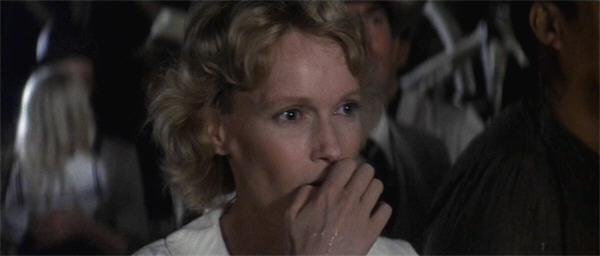
I bite my thumb at you, too…
Jason Robards’ performance as Captain Bruckner is the source of many of Hurricane’s laughs and squirms, though he is not entirely to be blamed: Bruckner as written is a crude cartoon, lacking only a tattoo across his forehead announcing, “I AM ONE OF THE UGLY AMERICANS!” Robards was one of the few people involved in this production to respond openly to Roger Ebert’s questioning—his openness taking the form of a frank admission that he was only there for the paycheque. It shows, to say the least—but to be fair, it is doubtful that any actor could have made much of the clumsily-written role. Robards doesn’t even try, instead snorting and huffing and glowering his way through the film, and reacting to everything by chomping on his cigar and/or baring his teeth at the camera. (In fact, I was put in mind of The Agony Booth’s complaint about Ben Affleck in Armageddon, that he acts with his teeth.)
When Hurricane opens, Captain Bruckner is anticipating the arrival of his daughter, Charlotte, who has travelled to Pago Pago from Boston for a visit. Anticipating is, in fact, putting it mildly: in one of this film’s more absurd touches, Bruckner harbours almost unconcealed incestuous desires for his daughter. However, that is of less import to the viewer than trying to decide how Charlotte feels about the situation.
Nastassja Kinski was originally intended for the role of Charlotte, but that piece of casting fell through when the production was caught up in the Polanski debacle. Mia Farrow, though still making a career out of playing fragile girl-women, was more than twice her potential predecessor’s age when she appeared in Hurricane, and simply cannot the convey the sort of unworldly innocence required to carry off this aspect of Charlotte’s character, wherein she is required, in effect, to be simultaneously “aware” and “unaware” of her father’s feelings. Her subsequent toggling between overt displays of affection towards him, and attempts to escape him, therefore tends to come across not as Charlotte trying to reconcile conflicting, if unacknowledged, impulses, but as an extended tease.

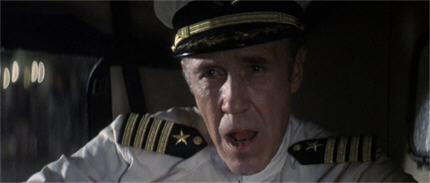
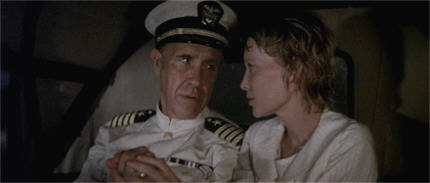
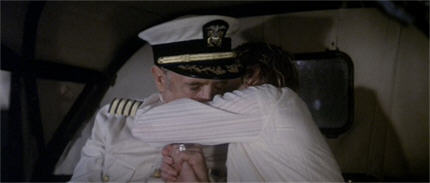
This is their least creepy interaction.
Be that as it may, the greeting between father and daughter sets the tone for everything to follow, being simultaneously laughably overwrought and just plain icky. It also offers the first appearance of a gesture that Mia Farrow will produce at various moments in an effort to convey Charlotte’s inner turmoil, wherein she bites the tip of her thumb and forefinger. The deliberate little-girl-ness of it gets more annoying with each appearance. And then there’s the fact that she switches from doing it as she contemplates her father to doing it as she contemplates Matangi…
It is pouring rain when Charlotte steps off her ship. It is also night-time; but neither of these details stops her from gazing around in delight and announcing, “I can hardly wait to get out my paint-box!” Charlotte’s devotion to “art” is the reason, or at least the excuse, for much of what she does in this film, but the viewer is not much surprised when the paintings she is supposed to be working on stay firmly in the realm of the Informed Attribute©.
Soaked to the skin though she is, Charlotte finds herself thrust into the middle of a surprise welcome party thrown for her by the rest of the American community. In the midst of a welter of introductions, she is reunited with the young naval officer, Jack Sanford, with whom she was apparently once romantically involved; but almost immediately her attention is caught and riveted by a young Samoan man, awkwardly isolated on the fringe of the noisy gathering…
Dayton Ka’ne was a professional surfer when he attracted the attention of Hurricane’s casting director. In typical De Laurentiis fashion, the producer talked up his “discovery” in the media, announcing that the young man had signed a three-movie deal with his company and hinting at big plans for the future—although as it turned out, Ka’ne faded from view after making only one more film, Beyond The Reef, aka Shark Boy Of Bora Bora (which I imagine I’ll be getting around to at some point). While Ka’ne’s performance as Matangi is undeniably one of Hurricane’s issues, it cannot justly be said he is any worse than anyone else—and he alone had the excuse of complete inexperience. None of the blame for Hurricane’s failures should rest on his shoulders.
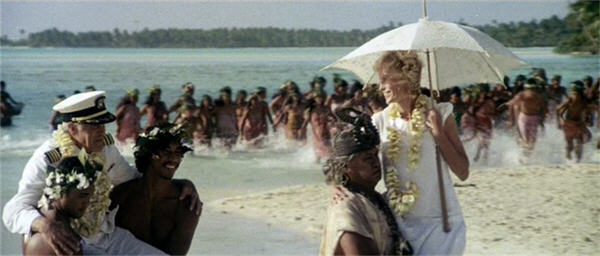
“Oh, Dad, I love it here! I’ve never felt so white!”
Instead, let’s focus on the fact that the script never bothers to clarify Matangi’s position with respect to Captain Bruckner: given the way he is dressed, and Bruckner’s attitude towards him, we take him initially for a servant (of course, Bruckner treats all the Samoans that way); although given the later revelation that the young man is heir to a neighbouring High Chiefdom, that cannot be so. At one point Bruckner punishes Matangi by making him copy out reports by hand, so presumably he is under Bruckner’s command in some way, perhaps placed there to learn White Man’s Law; but no dots are ever joined. (Nor does Matangi learn anything, as we will later discover…)
Apart from Dayton Ka’ne himself, there’s another piece of stunt-casting in Hurricane, with the small roles of Commander and Mrs Blair being played by Nick Rutgers and Nancy Hall Rutgers, real-life husband and wife, with the latter being the daughter of James Norman Hall, co-author of The Hurricane—and the cousin of Jon Hall, who played Matangi in the John Ford version. Mrs Blair’s introduction sets up one of the film’s more peculiar Captain Bruckner moments, as per the following exchange:
Mrs Blair: “My daughter’s gone tweedy, I’m afraid – she’s raising horses in Virginia.”
Bruckner: “Yeah, I thought her legs looked kind of bowed.”
Meanwhile—well, I don’t know if the stories about Mia Farrow and Timothy Bottoms were true, but they look uncomfortable enough together to make it a possibility. Charlotte and Jack Sanford are dancing (or anyway, rocking side-to-side on the spot, to stay in shot), and we get the following exchange:
Sanford: “Oh, Charlotte, it’s been so long!”
Charlotte: “Mmm.”
Sanford: “I’d forgotten what’s it’s like to dance with you!”
Charlotte: “Mmm.”

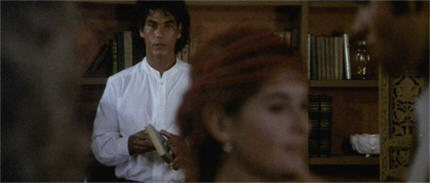
“I wonder if there’s anything interesting to do in Pago Pa—helllllloooooo…”
And this is before she loses interest in everything but Matangi!…an event that follows mere seconds afterwards, via, in this film’s usual amusingly unsubtle manner, a locked look that lingers long enough to catch the attention of pretty much everyone in the room, including Captain Bruckner and Jack Sanford. In what was presumably intended as an ironic bookend, the storm outside then intensifies, bursting open the shutters and briefly putting out the power. Charlotte turns from Matangi to throw her arms around her father and declare her love for him.
Ew.
The next morning brings the equally subtle, but less amusing, introduction of James Keach as Sergeant Strang, our teeth-clenching, nostril-flaring racist du jour “That ain’t right – ought never to talk to a white man like that in front of them,” he mutters, when Bruckner reprimands him over his local squadron’s inappropriate “raising of the colours” in the rain; although given that the reprimand consisted of a mock-threat to reassign Strang to the North Pole, we might judge this as a slight overreaction.
As Jack Sanford shows Charlotte around and delivers an info-dump about the American presence in Samoa, Charlotte makes eye contact with a native woman, who is watching her from the deck of a moored boat. (She’s a big one for Significant Eye Contact, our Charlotte.) As the white couple move away, Matangi calls out to the woman from a nearby balcony, clearly urging her to do something. The woman follows Jack and Charlotte into a market, and finally thrusts a note into Charlotte’s hand.
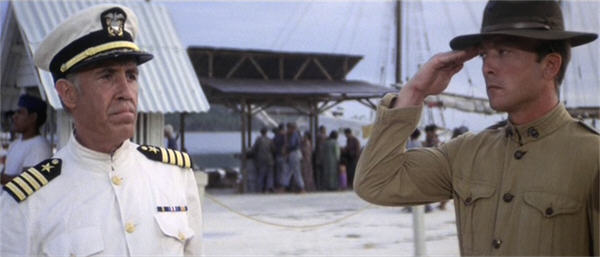
“Sure, you’re mad at me now; but just wait till you need someone to kick the crap out of your son-in-law…”
The note is written in Samoan, which leads to it being given to Matangi to translate. (Bruckner, of course, has not bothered to learn a word of the local language.) Matangi explains that the young woman has written to beg Charlotte to intervene on behalf of her fiancé, currently imprisoned for stealing a canoe—which he did “for love”, so that he could go to the young woman and protect her, after having a dream that she was threatened by a ghost.
Bruckner hardly knows which part of this to scoff at the most, but after mocking the locals as “children”, he settles for scorning the idea that, “I would ever accept love as an excuse for criminal conduct!”
By gum…I do believe that’s some Subtle Foreshadowing!
Nevertheless, Charlotte does try to intervene, prompted by Matangi’s claim that the young woman asked for her help because, “She looked once into your eyes, and she is sure you will understand what a person will do for love” – see also: Subtle Foreshadowing (though mind you, even Charlotte has trouble swallowing that) – only to suffer a smart slap-back from Bruckner, much to her disappointment and embarrassment.
The matter comes to a head when Bruckner realises that Matangi himself wrote the note, and is equally furious about his attempt to interfere with The Law – which, as you may have heard, Is The Law – and his involvement of Charlotte in his deception.
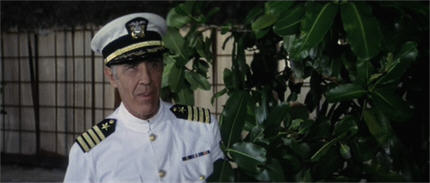
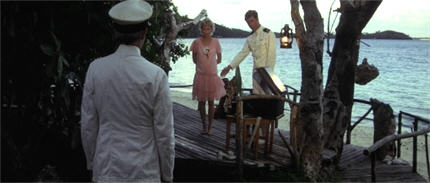
“You don’t mind if I watch from the bushes while you make time with my daughter, do you, Ensign?”
“No, sir! And if you’d like to cut in…”
Bruckner is still wondering why he puts up with Matangi when he learns he will no longer have to: his father has died, and the young man is now High Chief of the island of Alava, an island a day’s sail away from Pago Pago.
What follows represents one of Hurricane’s rare subtle moments, so we should highlight it: Bruckner busting up Jack Sanford’s attempt to romance Charlotte not by being nasty, but on the contrary by being overbearingly genial—remarking that he was young once too, and urging the two to stay out as late as they like. Not surprisingly, the next thing we see is Charlotte pushing Sanford away with a sharp, “Don’t!” and the tête-à-tête fizzling out. Clearly – as Sanford later makes explicit – Bruckner isn’t threatened by any of Charlotte’s naval romances, as he knows he can shove a spoke in their wheel any time he chooses.
On her way back to the governor’s residence, Charlotte orders her driver to let her out near the docks, which he reluctantly does. It’s pouring rain again, but Charlotte is not dissuaded from venturing onto that same moored boat. She claims to be looking for “that girl” when she is, inevitably, caught by Matangi, and typically, it is never clear if this is merely an excuse or not. The film’s interest, like Charlotte’s, is focused on the fact that Matangi is shirtless, in the first but by no means the last of the screenplay’s efforts to position him as Smouldering Samoan Sex-God.
I suppose it was felt that Charlotte’s behaviour needed to be explained or justified, whereas there was no need to explain the attractions of a skinny white blonde, but it’s fascinating to watch the way Hurricane fetishises its male lead, to the near exclusion of its female. In fact, this film is a little weird that way, albeit kind of refreshing: not only is its setting not made an excuse for ubiquitous female toplessness, the film’s only nudity is brief, and occurs under off-putting circumstances.

“My shirt was itching me…just like my pants are starting to itch me…”
We are then given a glimpse into the horrors yet to come via Charlotte and Matangi’s first attempt at flirtation:
Matangi: “How did you know you would find me here tonight?”
Charlotte: “Oh, I didn’t! I was looking for that girl who gave me the note – I saw her on this boat once!”
Matangi: “I see…”
Charlotte: “What do you see?”
Matangi: “I see you are getting very wet!”
Charlotte: “No wetter than you!”
Clearly feeling that she’ll never top that comeback, Charlotte then scuttles away—and we cut to Bruckner watching her arrival home from his windows, which underscores a significant failure of this film on the basic production level: the lack of any real sense of geography.
We get no idea of where the film’s different locations are supposed to be with respect to one another—here, for instance, we can’t tell if Bruckner can see Charlotte coming away from the docks, or if he’s just in a stew over how late she is. Similarly, there are weird time-cuts: it is still daylight when Bruckner intrudes himself upon Charlotte and Sanford, pitch black when Charlotte pushes Sanford away. This sort of carelessness happens again and again throughout the film, and underscores this as a production that people had lost interest in long before shooting had wrapped. It is particularly damaging during Hurricane’s climax, when it becomes impossible to know where anyone is, relative to one another.
An American delegation travels to Alava to witness Matangi’s ascension—and this, on top of the choice of location and the special effects, is where Dino De Laurentiis blew the budget on Hurricane, with numerous extras in elaborate costumes – and different extras in different costumes – and native ceremony after native ceremony. It’s all very pretty – as is Sven Nykvist’s photography of the island and its surrounding waters – but it’s filler; egregious filler, in a two-hour film of languid pacing. The only really interesting touch here is a short scene of Matangi undergoing ritual tattooing, prior to becoming High Chief.
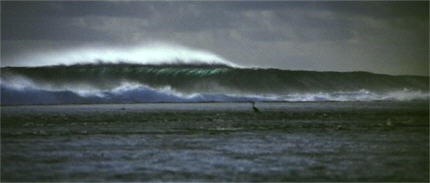

“And that, of course, is the famous Plot-Point Reef.”
As far as the plot goes, well, let’s see: we are introduced to Father Malone (Trevor Howard, bunging on a brogue so thick you could choke on it), and to Dr Danielsson, whose main function here is to point out a few of Alava’s notable features, including a reef that can be walked upon, when the tide is out; though the drop-off on the far side of the reef is a notorious danger-spot. (Charlotte’s squealing eagerness over the thought of walking on a reef is supposed to distract us from the latter detail. It, uh, doesn’t.) Meanwhile, the film misses no opportunity to emphasise Bruckner’s rudeness and contempt for the natives, for instance having him continue to chomp on a cigar while he is receiving a formal greeting from the island’s Prime Minister. From Mrs Blair, Charlotte learns that Matangi is shortly to be married – angst! – while Moana, Matangi’s destined bride, glowers at Charlotte all through the ceremony.
Matangi’s ascension requires him to swear a loyalty oath to the US government – or rather, “To the Most Supreme High Priest, President Calvin Coolidge” – but he infuriates Bruckner by tempering his oath with a promise to follow American laws only so far: “Such as I think they are good for my people.” He then challenges some of Bruckner’s recent judicial rulings. As billows of steam begin to issue from Bruckner’s ears and nostrils, Matangi informs him coolly that, in future, he should be addressed as “High Chief”, and not merely called by name.
Meanwhile, Mrs Blair gets the task of justifying Charlotte’s growing obsession, slavering over Matangi and insisting on his attractiveness to white women generally, and speaking enviously of Moana. We have heard that as High Chief, Matangi is not supposed to join the celebratory dancing, but later that night (after still more extras, costumes and ceremonials), he breaks tradition, much to the consternation of the tribal elders, performing a heated dance with Moana, all thigh-stroking and pelvic thrusting—but when the dance is done he stares past Moana at Charlotte, who is so aroused by this display that she responds by…gripping the arm of her chair…and of course by biting her thumb and forefinger.


“Let’s see: I’ve publicly challenged his authority, and insisted on being treated with respect. What else can I do that would piss him off?”
It’s all pretty embarrassing, actually.
Anyway, the next thing we know Charlotte is begging her father to let her stay on Alava. Dr Danielsson has invited her to be his guest, she explains hurriedly, and then starts blathering about her painting—the light, the colour…
Charlotte: “Father, please let me go! I mean, stay.”
This little slip provides an opportunity for the back-story of Charlotte’s mother, who ran away from her repressed, controlling husband when Charlotte was only six, presumably with another man, and who Bruckner has not forgiven in any degree. Cue more muttering about how love – passion – doesn’t excuse anything…
Bruckner finally gives in, telling Charlotte he will pick her up in one month’s time—when he returns for Matangi’s wedding. We cannot doubt this is meant as a dig, which in turn argues that Bruckner understands Charlotte’s real motives – so why is he letting her stay? And Bruckner’s not the only one: Jack Sanford departs with a blunt warning to Charlotte to be careful; that since he won’t be able to intimidate Matangi the way he does his young officers (present company included), Bruckner may be driven to extremes…
But Charlotte takes no notice, and before we know it, she and Matangi have plunged into a torrid love-affair.
Sort of.
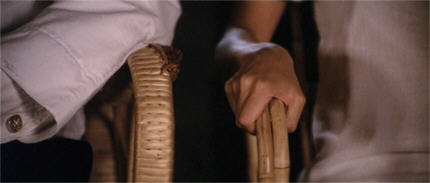

A Bostonian in the throes of uncontrollable sexual passion.
Hurricane’s attitude towards the Charlotte-Matangi situation is just bewildering. On one hand, the film itself seems smugly certain that its interracial romance is daringly transgressive; on the other, despite the story’s setting and circumstances, no-one in the film reacts to the affair on that basis.
They’re shocked from every other aspect; but apparently no-one sees anything untoward, in and of itself – in 1920s Samoa – in a white woman and a native man having sex. Dr Danielsson is worried but non-judgemental, Father Malone is properly horrified on moral grounds, Jack Sanford and Moana are angry and jealous, Matangi’s councillors shake their heads over his neglect of his duties—but the overwhelming reaction to the situation is simply dismayed anticipation of the magnitude of the shit-storm that’s going to break when Bruckner finds out.
Mind you, when I say “having sex”— For all that it builds itself around this romance, Hurricane is weirdly coy about its specifics. We spend twenty minutes – twenty minutes! – watching Charlotte and Matangi gaze and flirt and romp and swim and clutch at each other; only for the film then to pull back and leave us with only the signifier of Charlotte’s civilised shoes lying abandoned in a drifting canoe. (They are discovered there by Moana, who immediately grasps their significance.)
And oh, those twenty minutes!
To be blunt, Hurricane’s romance plot is numbingly tedious. To start with, the film gives us no reason at all to care about these two people, neither of whom has any discernible personality; nor is there any particular reason why they should care about each other—beyond the obvious “opposites attract” aspect of the situation.
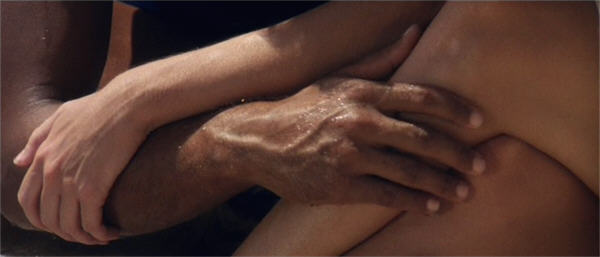
Are you titillated yet?
But even on that purely physical basis, the Charlotte-Matangi relationship is a complete failure: Mia Farrow and Dayton Ka’ne have no chemistry whatsoever, which turns the “torrid” affair between Charlotte and Matangi into an exercise in awkwardness. Furthermore, whatever the film tries to tell us about the characters, the reality is that Mia Farrow was ten years older than Dayton Ka’ne, and there is never a point when the age difference between them isn’t perfectly apparent.
Look—the last thing I want to do here is sound Hollywood-ageist. There’s absolutely nothing wrong with a woman being thirty-four. And there’s nothing wrong with a woman looking thirty-four. And there’s nothing wrong with a thirty-four-year-old woman fooling around with a twenty-four-year-old man.
Unless she’s playing twenty-one.
(In an interview after Hurricane had been completed, Dayton Ka’ne tried to keep positive about the entire experience, emphasising how much he liked Mia Farrow, how well they had gotten on, how nice she had been to him…except that the word he used to describe her was “motherly”, which pretty much sums up the issue.)
And frankly, I’m not sure Mia Farrow ever looked worse onscreen than she does here: not just thin and pale, as she always was – and of course, her “paleness” is part of the point – but tired, occasionally even haggard. If Farrow was indeed involved with Sven Nykvist during the shooting of Hurricane, there’s an irony in the fact that she is the one unflatteringly photographed thing in the film.
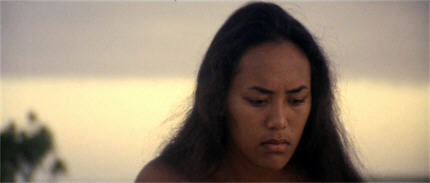
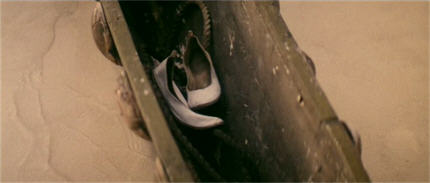
“When I get my hands on that bitch, I’m gunna bust a cap in her pasty white ass.”
But we can’t really blame the cinematographer. When Dino De Laurentiis, who had been away from Bora Bora for some time working up another production (Flash Gordon, probably), returned and looked at the rushes of Hurricane, he hit the roof over his leading lady’s appearance. It turns out that, perhaps buying a little too deeply into her character’s conversion into a child of nature, Mia Farrow decided unilaterally that she wouldn’t wear any makeup—not even the usual “I’m not wearing makeup” makeup. A shouting match between producer and actress led to Farrow capitulating on this point, but since she spent most of her remaining time on the set being hosed down and buffeted by wind-machines, it was too little, too late.
Ultimately, however, Hurricane’s most absurdly unrealistic step is to insist that its affair is not merely an affair: we’re supposed to accept that the relationship between Charlotte and Matangi is The Real Deal, La Grande Passione…and that Matangi wants to marry Charlotte!
Along the way Charlotte does try once or twice to bring Matangi to his senses, but he dismisses her arguments with, “A High Chief does what he wants!” and “A High Chief has to give no reason!”, and she allows herself to be swept along…until he demands that she meet him at the traditional altar for a binding exchange of flowers.
Really…the only fitting response here is a bray of disbelieving laughter. It would be one thing if the two of them wanted to run away together (although it’s hard to imagine how they’d manage it); but life together as Mr and Mrs High Chief—!? And you thought your dinners with the in-laws were awkward…
Matangi: “If the gods meant me for another, why did they send you!?”
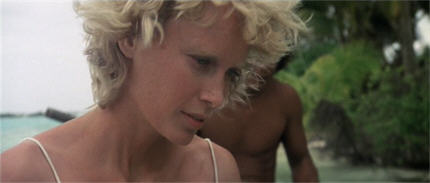
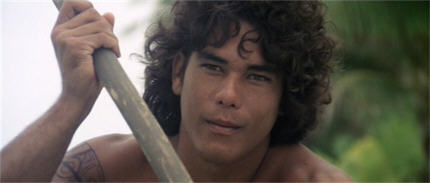
“That Oedipus, man… He knew a thing or two.”
Yeah, I hate to break it to you, Matangi, old bean, but the gods are rather given to screwing around with people.
Nevertheless, Charlotte’s rejection of Matangi’s proposal is set down to personal cowardice on her part, rather than to, you know, the fact that it’s a really stupid idea. It leaves him reluctantly picking up the threads of his long-abandoned duties, including his obligation to marry Moana.
This is rather unfortunate for Moana, who – like everyone else on Alava – is completely aware of what’s been going on; who has been following Matangi and Charlotte around in a rage of seething jealousy; who finally reacts to their liaison by impulsively giving herself to one of her own rejected suitors—and who now has to undergo ritual defloration prior to her wedding, as per tradition.
Uh, oops.
Charlotte, who has retreated to Dr Danielsson’s house, hears the native drums – you knew there would be native drums, right? – and is tempted to use “observing a native ceremony” as an excuse to see Matangi again; only for Danielsson to warn her away from this one. It turns out that Charlotte doesn’t know what “defloration” means, or at least she doesn’t know she knows…
The Charlotte-Bruckner business is just silly, but Hurricane gets genuinely distasteful here, finally chickening out – as per Charlotte’s shoes – but not before milking Moana’s situation for all it’s worth.
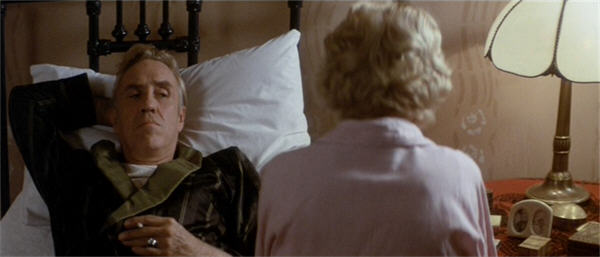
“Sure I’ve heard of Electra. What about her?”
At the critical moment, Moana gives her situation away with a panicky bolt from the ceremony. The onlookers interpret this correctly and set upon her with a roar of anger, beating her and tearing at her clothes. Matangi intervenes and frees her, but then must set out in pursuit of her as it becomes clear that she is heading for that deadly reef and suicide. He catches up with her and grabs her, but is unable to keep his hold on her, and she plunges over the edge of the reef…
The circumstances of Moana’s death give Bruckner the opportunity he’s been waiting for, as it turns out that outlawing the defloration ceremony “was almost the first thing the Americans did” when they took over governance of the region. Matangi is held accountable, and Bruckner sentences him to four years in prison, much to the horror of all, and the misunderstanding of none.
(If we were really cynical, we might suspect that Bruckner left Charlotte with Matangi precisely in order to create a situation that would justify him crushing Matangi like a bug; you know, omelettes, cracking eggs…)
Matangi is handed over to the tender mercies of Sergeant Strang, who is given the job of transporting him to prison. Strang takes full advantage (it is unclear whether he knows about Charlotte, or whether he just views Matangi generally as an uppity you-know-what), but the truck breaking down on the way gives Matangi the chance to escape. A desperate dash across the island and an attempt to swim after a departing sailing-ship just fails, and Strang catches up with the exhausted Matangi—having, in the interim, been demoted to private. He takes this out upon Matangi before successfully incarcerating him in a military transport ship.
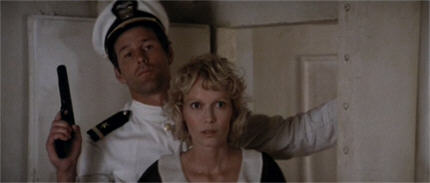
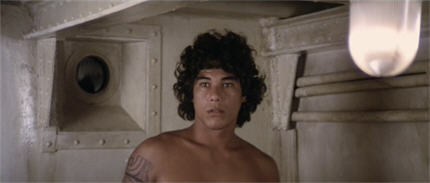
“I just couldn’t leave without seeing you with your shirt off one last time…”
Charlotte’s initial reaction to Matangi’s sentencing is to declare her intention of leaving on the first boat, but she later amends this to, ahem, offering to become her father’s permanent “companion”, and suggesting that they use his leave to go travelling together: “I’ll be as close as you want me to be…”
Bruckner’s involuntary chop-licking is cut short when he learns Charlotte’s price, which is a little high for him; though he puts his refusal in grandiloquent terms, as being above bargaining with either love or justice.
Or, presumably, whatever this is.
So, with her attempt to seduce her father failing, there’s nothing left for the governor’s well-brought-up Bostonian daughter to do but stage a prison break.
Seriously…where did she even learn what a shiv is, let alone how to fashion one out of a spoon? Convent school?
But anyway, having persuaded Jack Sanford to let her see Matangi, on the pretence of persuading him not to try and escape again, Charlotte slips him this useful implement so that he can stage a fake hostage-taking. Sanford seems convinced of Charlotte’s danger and gives in to Matangi’s demands with almost embarrassing promptitude. (It’s easier to believe he’s just playing along for Charlotte’s sake, but that’s not the vibe.) All is going well and non-violently until, of course, a drunken Private Strang wanders into the middle of things. He jumps Matangi just as he and Charlotte are about to slip off the boat. In the ensuing struggle, Matangi drops Sanford’s confiscated gun. Charlotte picks it up and pistol-whips Strang, and Matangi slams him into a wall before tipping him overboard…
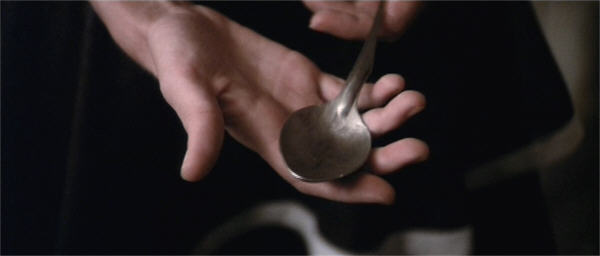
“Sister Mary Margaret always said I had an aptitude…”
This interlude barely slows our lovebirds down, though, and they hurry towards the boat that Charlotte has arranged. She tells Matangi that this first vessel will carry him to Alava, where a second boat is waiting for him, and insists that he leave her on the dock, tied up as a cover. Of course, Matangi doesn’t want to go without her, and precious time is wasted over arguments and kissing. She keeps trying to send him away, but at the last moment Matangi compels her to take the jump into the water with him, and they end up scrambling into the boat together.
While all this is going on, a few rumbles of thunder are heard…
Bruckner is all over what ships might have left port, but Charlotte thought of that, arranging for the Catapua to publicly sail away some hours before the planned escape. By now Strang’s body has been fished out of the water, which allows a seething Bruckner to dwell upon the satisfying mental image of Matangi being strung up when they catch him.
Bruckner: “He’ll hang for it – and anyone who aids and abets him will hang too!”
Uh, oops.
Meanwhile, a storm has broken, though not that much worse than we’ve seen before—but bad enough that the engine of the Catapua burns out, making its owner insist they turn back, as it will be too dangerous to try and navigate through the narrow opening in the reef without an engine. However, in the face of Charlotte’s terror – and her word-picture of her father’s likely activities – he agrees to try for Alava as first planned. It is Matangi who kiboshes this; and in the end he and Charlotte let the Catapua’s owner off the hook by setting out alone in its lifeboat (!).
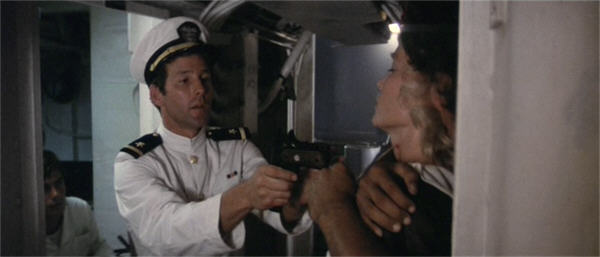
“No, no, I understand perfectly why you want to kill her! As a matter of fact, why don’t you use my gun?”
Bruckner, meanwhile, is copping heat from Pearl Harbor over his various demands, which include a hydroplane to help with the search. He is brought up short, however, when Sanford mentions that the returned Catapua came back into harbour missing its lifeboat…
At this point I should probably reiterate that Alava is a day’s sail away from Pago Pago under standard conditions, since the film itself has clearly forgotten that detail: as dawn breaks, Matangi and Charlotte find themselves just outside the reef. How they managed to navigate there through the storm in their dinky little boat, with its wooden tiller and its ripped sail and its oars, is left to our imaginations… Our lovers drag themselves onto the island, where the people of Alava are fleeing the shore for higher ground.
Charlotte and Matangi seek refuge at Dr Danielsson’s house; the good doctor, as with everything, takes their arrival in his stride, ordering blankets and warm drinks; though he warns them that once Bruckner has exhausted the possibilities of Pago Pago, he will certainly try Alava. Matangi insists that they will be gone in the waiting boat before then, “As soon as the wind drops. The wind is good luck – good luck!” – to which the storm responds by wrecking the decorative façade of Danielsson’s house. Matangi’s idea is that “the wind” will prevent the search from setting out until after he and Charlotte have left Alava, which only goes to show that he doesn’t know his prospective father-in-law as well as he should.
Sanford, meanwhile, is making an inevitably futile attempt to persuade Bruckner to give up his plan to land himself on Alava, arguing that their boat will be ripped apart at anchor, and accusing him of endangering a naval vessel for personal reasons—which provokes some of Jason Robards’ most hilarious teeth-acting, as Bruckner in turn accuses Sanford of aiding and abetting. Subsequently, Bruckner, Sanford, two other naval officers and two marines struggle ashore and set out through the violence of the storm to the village.
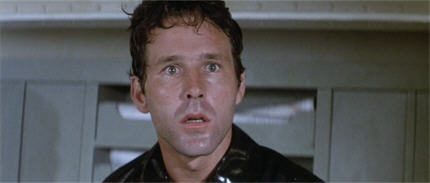
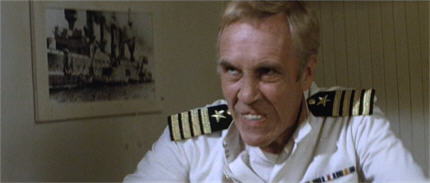
Jack realised too late he should never have used the expression, “Bite me.”
At Danielsson’s prompting, Matangi goes out to help the other people of Alava (he suggests young people tied high in tress, older people in the church); and in a piece of exquisitely bad timing he runs straight into Bruckner, who has him handcuffed to a post where the water is already rising…
Bruckner and his men then stagger on to Danielsson’s house. There is a momentary reunion between Bruckner and Charlotte, but almost immediately she sets about trying to convince her father that Matangi has been killed—only of course, the naval men know better. When Bruckner throws his intention of hanging Matangi for the murder of Strang in her face (assuming he doesn’t drown first; but hey, it’s all good), Charlotte turns on her father and announces that she hit Strang, that she planned the prison-break, that she was never Matangi’s hostage…
“I LOVE HIM!!” she shrieks, just as The World’s Most Symbolic Hurricane strikes…
Fun fact: the word “hurricane” is never actually spoken during Hurricane—one indication of how strangely slow the characters are to acknowledge that they have more than just an unusually severe storm confronting them. Granted, at this point most of them are, shall we say, a tad distracted…and as a result, the hurricane makes an entrance rather like that of the T-Rex in Jurassic Park: despite being very big and very noisy, it nevertheless manages to sneak up while everyone is focused on something else.
The storm sequence occupies the final thirty minutes of this two-hour film—the prior ninety minutes of which, despite some admittedly lovely visuals, are rather an endurance test—and I wish I could tell you that it’s worth the wait; that the special effects make it worth your while to wade through the ridiculous character stuff. Unfortunately, that’s just not the case.

“A three-hour cruise, huh?”
It might seem that I’m being unfairly harsh here, given that we are dealing with a disaster movie, after all: a genre not exactly known for either its subtlety or its complex plotting. Hurricane is certainly not the only such film to serve up stereotypes instead of characters, or to spend far too long dwelling on an uninteresting romance, or to cross – or rather, leap over – the line separating “drama” and “melodrama”. In fact, when it comes to disaster movies, it doesn’t always matter how bad and/or stupid they are…as long as they are entertaining…and this is the test that Hurricane fails: the special effects don’t compensate for everything else that’s wrong with the film, so that the film in its entirety – not just in its “human interest” (so-called) material – leaves behind it a sense of disappointing hollowness.
There’s no failure of effort, by any means, but the end result is lacking. There’s an awful lot of water here, but not a lot to look at, somehow. Perhaps it’s the way the scenes are put together, or the obvious artificiality of the lighting, but overall the special effects in Hurricane anticipate the complaint often made these days about CGI, that it fails to “fool the brain”: apart from some impressive shots of destructive crashing waves (not stock footage, exactly, but clearly filmed somewhere else), there are few moments here when you are not conscious that what you’re watching was shot in a tank.
It’s a curious thing, that: after all, John Ford’s hurricane sequence was mostly shot in a tank, too (much to the disappointment of its director, who had signed on for the film in anticipation of capturing real footage in the Pacific), but the results there are convincing and often scary. The two films offer up the same set-pieces, which presumably originated in the novel, so a direct comparison is simple. There’s no question that the use of black-and-white cinematography gives the earlier film an unbeatable edge; the colour photography here fails to hide the fakery in quite the same way. Ultimately, the hurricane in Hurricane is to the hurricane in The Hurricane as the earthquake in Earthquake is to the earthquake in San Francisco—for all the presumed advances in technology, a disappointing shadow of its more “primitive” forebear.
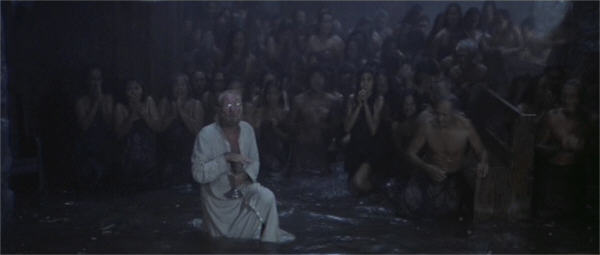
“Perhaps I should mention, Lord, that I’ve just been talking up Your mercy to these people…”
(Tell me…do you think it’s just possible that I watch too many disaster movies…?)
The other problem here stems, I think, from Jan Troell.
I promise—I swear, hand on heart—that I will never, ever again compare Jan Troell unfavourably with Irwin Allen, but—
The fact is, Allen knew how to shoot this stuff; he understood that his audience wanted to enjoy the disaster sequence: escapism meets Schadenfreude. Troell, in contrast, is to the very end trying to shoot a serious drama…with the result that he too often makes us feel bad, often by putting emphasis upon the disaster’s innocent bystanders. It’s kind of hard to enjoy Captain Bruckner’s comeuppance when the camera, a moment before, is dwelling upon doomed Samoan babies.
But even that is not this film’s crowning blunder, which comes during its final few frames. While the earlier version ends with its Matangi escaping to freedom with his wife and child, John Ford understood that the story is nevertheless a tragedy, which is another reason why that film is not a disaster movie.
Hurricane, on the other hand—
Hurricane seems to think it has a happy ending…
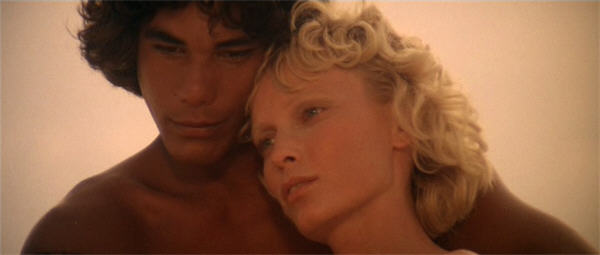
“But looking on the bright side…”

“…it will be easier to pursue our forbidden interracial love affair…”

“…now that everyone else is dead.”
.
More on Hurricane at Spinning Newspaper Injures Printer.
************************************************************************************
This review is part of the B-Masters’ examination of the career of Dino De Laurentiis.


Pingback: It blows! « The B-Masters Cabal
It sounds as if the best way to watch this movie is with the sound off, and fast-forwarding through any scenes with Mia. Just enjoy the scenery.
LikeLike
btw, I went to IMDB to see the comments on this, and one of the keywords is ‘bare chested male’. I didn’t realize there were enough movies available to make that a valid keyword. I’ll have to check out the other movies with that keyword.
LikeLike
I’m guessing that keyword would cover 90% of ’80s Hollywood action movies, especially those starring the Big Two.
LikeLike
True up to a point, but I don’t think those films were an invitation to ogle the way this one is.
LikeLike
Well, there’s no shortage of silly dialogue, but—yes, that might be the most painless option!
I can’t say that I was previously aware of “bare-chested male films” as a genre either…
LikeLike
Great stuff, Liz. Few producers did excess like 70’s era Dino, though I’m partial to Orca when it comes to his 70’s output. I’m planning on covering some Dino flicks on my blog at some point.
LikeLike
Thanks, Ed! Uh, enjoy, if that’s the right word?
LikeLike
Depends on the film, really.
LikeLike
I remember seeing this on cable TV waaaaayyyy back in the early 80s. Your write up was more entertaining than the movie.
LikeLike
Hi – thanks!
Love your avatar, by the way…. 😀
LikeLike
One never watch too many disaster movies… Keep them coming! A question: Mia Farrow, in this film, is worst than in Avalanche? She is a disaster herself in that one.
LikeLike
A very good question and one I look forward to investigating! 😀
Although—really we can’t entirely blame the actors here: the script is terrible, and they respond accordingly. Farrow and Ka’ne are awkward, Robards and Howard are over the top, Bottoms is embarrassed… Only Max Von Sydow escapes with his dignity intact.
This comes back to what I was saying about this film being just like King Kong. What do we remember there? Isn’t it, “You male chauvinist pig ape!”?
LikeLike
If you get the Avalanche blu-ray, be forewarned that the sound goes completely out of sync at one point during the titular event. Kino Lorber’s QC apparently missed it because it’s chaotic audio over chaotic video, but it’s painfully obvious to someone actually sitting down and watching the movie.
But…is Avalanche worse? It’s hard to say. It is, of course, cheaper, being a Roger Corman production; while the tank shots in Hurricane are phony in that vague, “I-sense-stage-lighting” manner, Avalanche intercuts scratched-to-hell stock footage with complete-failure matte work, the occasional unconvincing miniature, and actors rolling around in piles of Styrofoam chunks moving at one-twentieth the speed of the avalanche in all other shots. (Side note: some of that complete-failure matte work was recycled for Meteor.) Hurricane naturally has the better photography.
The romantic triangle around Mia Farrow is less squicky than the one in Hurricane, at least. In my mind Farrow doesn’t have chemistry with anybody (I know someone’s going to throw something at me for this but the only performance of hers I can stomach is in The Last Unicorn) onscreen or off, but at least Hudson and Forrester are closer to her age. Forrester is the only one of the three interested in turning in an actual performance, so naturally he gets the least opportunity to do so while Farrow and Hudson have a who’s-the-most-bored-with-this competition. Jeanette Nolan’s flirting captured more of my attention. If you’re looking for gratuitous squick, there’s some hot tub toplessness, a sports celebrity committing statutory rape, and a suicide interrupted by Styrofoam.
Avalanche‘s story is crap, even for a disaster movie. It has the usual “only one maverick sees the danger” and “we can’t shut down in the middle of the tourist season!” tropes, but incredibly the climax has nothing whatsoever to do with the avalanche. Can you imagine The Towering Inferno or Airport ’77 ending with a traffic accident? The script’s sole salvation is the occasional wicked irony in dispatching minor characters. William Kraft’s score is less grating than Nino Rota’s Hurricane theme, so there’s that. But unless you’re an absolute disaster-film nutter (hi) or a fan of one of the cast or crew, I’d recommend staying away from both movies.
LikeLike
…and of course, I meant Robert Forster and not Dr. Clayton Forrester.
(slaps self with large trout)
LikeLike
I guess the answer to that is that to me, Avalanche‘s cheapness is part of the fun; much more fun than the expensive but hollow prettiness of Hurricane. And anything that does “We can’t close the [whatever] because of [money-making venture]!” is already onside with me. 😀
But unless you’re an absolute disaster-film nutter
Uh, there’s some question about that!?
LikeLike
On the spot opinion about Avalanche, the only redeeming quality of that movie was the charming relationship between Nolan and Steve Franken… (but I’m a disaster- film nutter, so..)
LikeLike
Ooookay, the first thing that struck me here is the name “Matangi” for a Pacific Islander, and I’m kind of stuck on it. I did a brief internet look around for Samoan and Polynesian languages, and that “ng” sound does not come up much if at all. It really sounds like the kind of thing an Edgar Rice Burroughs type without access to Google would make up because they thought it sounded exotic and damn the geographic region.. .Matangi is a Hindu goddess and it’s a word in the Cook Islands Maori dialect, but that’s about all I got.
LikeLike
Well, the name “Matangi” originates in the novel, which is set somewhere else: they’re not explicit in the first film, and I don’t know if the novel is. I don’t imagine it would have occurred to anyone here that they might need to adjust the character’s name with the setting, but you’re quite right about the language usage differences. You do get ‘ng’ in Maori and you also get the sound in Fijian, although they spell it without the ‘n’.
LikeLike
Fair enough! It was something that felt off to me, but I don’t know any more about it than the filmmakers.
Something I can legitimately criticize, though: didn’t Bo Derek do that same finger-bite gesture to indicate overwhelming passion in her Tarzan movie?
LikeLike
Ooooohhh… Was it that, or did she just bite her forefinger? (I’m blocking it out!) Either way, you’re right on the gesture and the implication—just as annoying, too! 😀
LikeLike
Change one letter and poor Ka’ne becomes one of the Mushroom People. Now there’s a movie I’d like to see!
LikeLike
“You love ’em in Red, and you love ’em in Blue”. XD Sorry, but the Mia-biting-her-thumb brought back ‘Megaforce’ flashbacks.
And uh, yeah. I could get into a love affair about a 30 something woman and a handsome, exotic younger man, but Mia Farrow playing a 21-year-old here? She looks horrid in these photos, too. And that icky subtext? Dino, Dino, Dino…. XD
As an aside, did US Navy officers really wear those Whites all the time? It seems unlikely, except at important occasions.
LikeLike
Yes, that crossed my mind, too… 😀
Don’t know about the wearing of whites (someone here is probably more knowledgeable about that than I am) but I can imagine that since this was government, it would always be considered an important, or formal, occasion.
LikeLike
The uniforms look like standard issue Service Dress White uniforms which are used for formal functions. There are scaled down ones for standard duty and office work but it looks like the film, despite the rather outsized budget, could only afford the one style. Granted they look snazzy and all but generally they would be in either Summer White Service or Service Khaki for everyday stuff.
LikeLiked by 1 person
Oh, that’s right. He was pretty much on diplomatic duty all the time. I’d guess he had a native valet or batman to help him dress, anyway.
LikeLike
@Ed – Thank you. 🙂 My reply to Lyz posted before I saw your reply RE:White uniforms. That makes sense to me.
LikeLike
I don’t think Dino ever cared whether his films were critical successes, as long as people paid to see them.
I know someone who cut Equilibrium to the Good Parts Edition: the fight at the beginning, the fight in the middle, and the fight at the end. Surely something can be salvaged from all those locations and effects shots?
He’s a four-limbed mammal with bipedal gait. So’s she! They’re made for each other!
Yeah, you could tell a perfectly good story about a love between a thirty-four-year-old woman and a twenty-four-year-old man, but it wouldn’t be one that paints the woman as an ingénue who’s flirted a bit and now finds herself in the throes of her first real passion. (Mia Farrow ought to know about age differences; Dory Previn’s Beware of Young Girls was written about her some years earlier. It’s on youtube.)
LikeLike
I think Dawn has the right idea here: just turn down the volume and look at the pretty pictures.
No-one much paid to see this one…
LikeLike
don’t forget to fast-forward through all Mia’s finger-biting scenes..
LikeLike
If we’re going to get nitpicky about uniforms, then it must be noted that these days, the term “Hurricane” is used for tropical cyclones in the Atlantic and Eastern Pacific. “Typhoons” are those storms in the Western Pacific (near Japan and the Philippines). In the Southern Pacific, where Samoa is, they aren’t given a special name. I haven’t yet found information about when the terms “hurricane” and “typhoon” came in to general use, but it would have been more appropriate to call the movie “Typhoon”.
Not referring to the storm by a special name, especially considering the state of weather forecasting in a remote location in the 1920s, is probably one of the more accurate things in the movie…..
LikeLike
Though all that goes back to the novel, which was published in the mid-30s. “The weather”, “the wind” and “the storm” seem slightly inadequate to describe an event that (as far as we know) completely destroys Samoa, particularly when it is clear quite early on that this is more than just an unusually severe storm; some acknowledgement would seem in order. “Oh, crap! It’s…one of those…you know, big things!” 😀
We should note that there is a rip-off of John Ford’s The Hurricane called Typhoon (also dealt with in Et Al.).
LikeLike
Strange… I have never before heard of Hurricane despite it’s large budget, well known cast and (apparently) quite a lot of publicity during production. I have however heard of Shark Boy Of Bora Bora. Back when it was being made I was just learning to sail and was obsessed with sailing in the way only a ten year old can be obsessed with something so I was reading everything I could get my hands on regarding the subject. An issue of Sail magazine had a story by a man named Webb Chiles who was attempting to sail around the world in an 18 foot, open Drascombe Lugger sailboat and he happened to be in Bora Bora when Shark Boy was being filmed. I still remember what he said in the article: “The high standard of this film can judged by the final scene, in which the script calls for the boy and girl leads to ride out the pass and into the sunset on the back of the shark. I regret that I do not know if they are wearing cowboy hats.” One really sad thing is reading the description of Bora Bora he wrote, seeing the stills of the island in this review and comparing them to what the island looks like today. Still, I would love for you to cover Shark Boy/Beyond The Reef someday. The cheesiness of the little bit I saw online makes me hopeful that at least they may not have actually harmed any real sharks while making it…
LikeLike
No, this one sank very fast (if you’ll pardon the expression), and lacking any reason to be “rediscovered” later, stayed sunk. It’s one of those films where it is much easier to find pre-release information than post-release reaction. All the other reviews I did find were from its initial release; very few people have paid the film much attention since.
It gets better: Shark Boy Of Bora Bora has the boy raising a tiger shark from a baby. Yeah, the potential for shark harm does make me wary, though I’m delighted to hear that one shark at least gets to swim off into the sunset at the end! 😀
LikeLike
Matangi: “I see you are getting very wet!”
Charlotte: “No wetter than you!”
Woah! Parental Discretion Advised! Man, what writers got away with…
LikeLike
And stand by for hot hand-holding ACTION! ACTION! ACTION!
LikeLiked by 1 person
Very nice job! Your piece was very entertaining to read, even as it successfully conveyed the dullness of the subject. I will be staying away from this one, as I’m not a disaster movie aficionado. Indeed, I’ve only seen a handful, and most of those were Siffy movies. I haven’t seen any of the heavyweights of the genre. (Unless we’re counting The Swarm…the extended version no less, thanks to Ken Begg, that dick.) The last one I tried to watch was Avalanche, and I feel asleep during it. Perversely, I was awake for all the character interaction and missed all of the avalanche stuff, save for a brief awakening when that one poor girl dies. However, this was during the long haul that is B-Fest, so I’m sure if I try again I’ll get through it.
LikeLike
And certainly you don’t want to go near this unless you’re a hard-core disaster nutter.
thanks to Ken Begg, that dick
Hey, we’ve all been there. 😀
LikeLike
I’m like Charlie Brown with that damn football. I know he’s going to play something horrible, and yet I go anyway.
LikeLike
This on a thread on which Megaforce has already been mentioned, sigh…
LikeLike
Megaforce is a rare Jabootu movie I can’t blame that dick for; I saw that before I ever read his site. However, I can blame him for Chastity and The Lonely Lady, along with The Swarm, which should be enough to completely fuck up his karma for several reincarnations. So there’s that.
LikeLiked by 1 person
Every time I go to your home page and see the quote, “If the gods meant me for another, why did they send me you?” I want to answer, “because they HATE you!”
LikeLike
And you’d be right to do so. 😀
LikeLike
I can’t remember the last time that I laughed so long and so hard as when I read this. What a masterpiece of satirical writing; even the photo captions had me in spasms. I must be the hardest of hard-core disaster junkies, because I love Hurricane. Stone me if you will, but I will watch it twice before ever sitting through Dino-baby’s Kong again; I’ve refused to take a peek at it since I first saw it on the big screen on its initial release. My suggestion is to have someone record this review in its entirety, and add it as a commentary track on any further DVD issues of Hurricane. I have, in fact, posted this link to my FB page as well as on the IMDB message boards.
LikeLike
Hi, Rafe – welcome, and thank you very much!
I’m a big believer in “there’s no disputing about taste”, and least of all, I think, when it comes to disaster movies! Considering some of my favourites, I assure you that you’re quite safe from stoning here! 😀
LikeLike
Pingback: Spinning Newspaper Injures Printer | and you call yourself a scientist!?
Considering that Mia Farrow married a man who quite literally could have been her father (as in, Frank Sinatra and Maureen O’Sullivan were apparently having an affair uncomfortably close to the time when Mia was conceived), she may actually have been a better choice than Ms. Kinski for these gross antics.
LikeLike